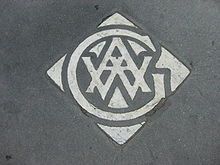Art Workers' Guild
This article needs additional citations for verification. (January 2017) |


The Art Workers' Guild is an organisation established in 1884 by a group of British architects associated with the ideas of William Morris and the Arts and Crafts movement.[1] The guild promoted the 'unity of all the arts', denying the distinction between fine and applied art. It opposed the professionalisation of architecture – which was promoted by the Royal Institute of British Architects at this time – in the belief that this would inhibit design.[2]
The founders of the guild were five young architects from Norman Shaw's office: W. R. Lethaby, Edward Prior, Ernest Newton, Mervyn Macartney and Gerald C. Horsley.[3][4] Its first master was the sculptor, George Blackall Simonds;[5] its second master was John Dando Sedding. Among its members was Henry Bird.[citation needed]
The architects Dunbar Smith and Cecil Brewer had an office in the front of the early Georgian house at 6 Queen Square, Bloomsbury and, when they heard that the freehold was for sale, encouraged the guild to buy it.[4] The back part of the building was reconstructed as a meeting hall, designed by F. W. Troup and inaugurated on 22 April 1914. It is furnished with rush-seated chairs made in Herefordshire by Philip Clissett and his grandsons between 1888 and 1914, and afterwards copied by Ernest Gimson and his successors. The names of all members up to the year 2000 are painted on a frieze around the walls of the Hall. The list of names now continues in the front room known as the ‘Master’s Room’.[citation needed]
The Art Workers Guild gave rise to the Arts and Crafts Exhibition Society.[3]
The guild began as a male-only organisation, leading May Morris to start the Women’s Guild of Arts in 1907 as an alternative for women.[6] It was not until the 1960s that women were admitted, starting with the wood engraver Joan Hassall who became the first female Master in 1972.[7]
The guild is today a society of artists, craftsmen and designers with a common interest in the interaction, development and distribution of creative skills. They represent a variety of views on design and stand for authenticity (irrespective of political and stylistic ideology).[citation needed]
The Art Workers' Guild today is a body of more than 350 artists, craftspeople and architects working at the highest levels of excellence in their professions. They represent over 60 creative disciplines. Their main charitable aim is to support the visual arts and crafts in any way that may be beneficial to the community.
Past Masters of the Guild[]
|
|
|
References[]
- ^ Henri Jean Louis Joseph Massé. The Arts Workers' Guild, 1884-1934.
- ^ Crouch. C (2002). Design Culture in Liverpool, 1880-1914: The Origins of the Liverpool School of Architecture. p. 61-63. ISBN 9780853238843.
- ^ Jump up to: a b "The Art Worker' s Guild". Victorian Web. Retrieved 3 August 2021.
- ^ Jump up to: a b "UCL Bloomsbury Project - Art Workers Guild". UCL. Retrieved 3 August 2021.
- ^ Reva Wolf and Alisa Luxenberg. Freemasonry and the Visual Arts from the Eighteenth Century Forward Historical and Global Perspectives. Bloomsbury. p. 203–226. doi:10.5040/9781501337994.ch-009.
- ^ Thomas, Zoe (June 2015). "'At Home with the Women's Guild of Arts: gender and professional identity in London studios, c. 1880–1925'". Women's History Review. 24 (6): 938–964. doi:10.1080/09612025.2015.1039348. S2CID 142796942.
- ^ Past Master List. Art Workers' Guild.
- ^ Bryant, Mark. World War I in Cartoons. London: Grub Street Pub, 2006, page 17, ISBN 190494356X
- ^ Past Master List. Art Workers' Guild.
Further reading[]
- J. L. J. Masse, The Art-Workers Guild 1884–1934 Oxford: Printed for the Art-Workers' Guild at the Shakespeare Head Press, 1935. OCLC 559542296
External links[]
- "Art Workers Guild". Official website of the Guild. Archived from the original on 24 October 2005. Retrieved 17 October 2005.
- Gavin Stamp. "A Hundred Years of the Art Workers Guild" (PDF). Retrieved 10 March 2013.
- The Guild Constitution
- Artworkers’ Guild History
- British art
- Interior design
- Arts and Crafts movement
- Arts organisations based in the United Kingdom
- Architecture organisations based in the United Kingdom
